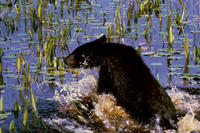You are in: North America -> Canada -> Nahanni National Park, and traditional search or Image Gallery will yield results of this site only
Nahanni National Park
| Site number: | 24 |
|
| Type of site: | Natural | |
| Date of Inscription: | 1978 | |
| Location: | North America, Canada, Northwest Territories | |
Up to 75 images are shown here. Click on each for more details or on Image Gallery for more images.
Six official UN languages:
Arabic,
Chinese,
English,
French,
Russian,
Spanish
Other languages: Czech, Esperanto, Finnish, German, Hungarian, Italian, Lithuanian, Polish, Portuguese, Swedish
Other languages: Czech, Esperanto, Finnish, German, Hungarian, Italian, Lithuanian, Polish, Portuguese, Swedish
| Description: | Nahanni National Park situated along the South Nahanni River (one of North America’s most spectacular wild rivers), includes deep canyons, huge waterfalls, and a unique limestone cave system. Residing in the park are animals of the boreal forest, such as wolves, grizzly bears and caribou reside in the park and the park's alpine environment houses Dall's sheep and mountain goats. --WHMNet paraphrase from the description at WHC Site, where additional information is available. | |
| Nahanni National Park Reserve in the Northwest Territories of Canada, approximately 500 kilometres (311 miles) west of Yellowknife, protects a portion of the Mackenzie Mountains Natural Region. The centrepiece of the park is the South Nahanni River. Four great canyons, called First, Second, Third and Fourth Canyon, line this spectacular whitewater river. The name Nahanni comes from the indigenous Dene language and can be translated as 'spirit.' At Virginia Falls, the river plunges 90 metres (295 feet) in a thunderous plume. It is more than twice the height of Niagara Falls. In the center of the falls is a dramatic spire of resistant rock, called Mason's Rock after Bill Mason, the famous Canadian canoeist, author, and filmmaker. There is a proposal to rename the falls after former Canadian Prime Minister Pierre Trudeau. Aside from the falls, there are many notable rapids on the river including Figure Eight, George's Riffle, and Lafferty's Riffle. The park's sulphur hotsprings, alpine tundra, mountain ranges, and forests of spruce and aspen are home to many species of birds, fish and mammals. A visitor centre in Fort Simpson features displays on the history, culture and geography of the area. The park was among the world's first four natural heritage locations to be inscribed as World Heritage Sites by UNESCO in 1978. Originally established in 1972, by then Prime Minister Pierre Trudeau, the park was 4,766 square kilometres (1,840 square miles) in area. In 2003 an agreement between the Dehcho First Nations and Parks Canada gave temporary protection to 23,000 km² (8,880 sq mi). In 2007 Prime Minister Stephen Harper announced that an extra 5,400 km² (2,085 sq mi) would be added, bringing the total area to 28,000 km² (10,811 sq mi). The only practical way to get to Nahanni National Park is by float plane or by helicopter. Around 800-900 people visit the park every year. --Wikipedia. Text is available under the Creative Commons Attribution-ShareAlike License. | ||
| Source: | http://whc.unesco.org/en/list/24 | |
| Reference: | 1. UNESCO World Heritage Center, Site Page. | |





















